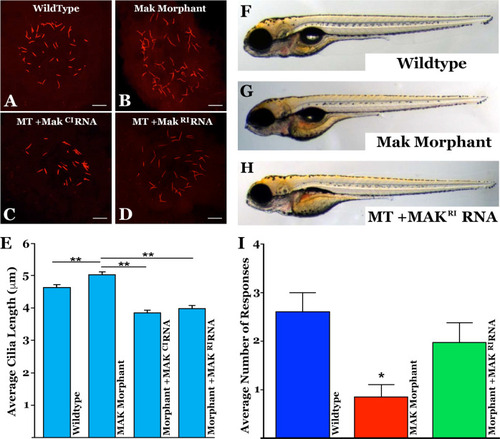Fig. 4
- ID
- ZDB-FIG-220701-34
- Publication
- Tucker et al., 2021 - Development and biological characterization of a clinical gene transfer vector for the treatment of MAK-associated retinitis pigmentosa
- Other Figures
- All Figure Page
- Back to All Figure Page
|
Injection of MAK mRNA restores Kupffer?s vesicle cilia length and response to visual stimulus in a mak mutant zebrafish model.
A?D Immunocytochemical labeling of primary cilia with an anti-acetylated tubulin antibody within Kupffer?s vesicle in uninjected (A), mak morpholino-injected (B), and morpholino-injected zebrafish that simultaneously received canonical MAKCI (D) or retinal MAKRI mRNA (D). E Quantification of mean cilia length measured in each treatment group shown in A?D. MAK morphants displayed significantly longer cilia compared to uninjected siblings (uninjected vs MO only; p?=?0.0004). Sequential injection of retinal MAKRI mRNA or canonical MAKCI mRNA significantly shortened primary cilia length (MO only vs MO?+?RNA; p?<?0.0001 for both). F?H Light micrographs of wildtype (F), MAK morpholino-injected (G), and MAK morpholino and retinal MAK mRNA injected (H) demonstrating normal overall morphology among groups. I Histogram depicting the number of responses in the vision startle assay of wild-type, MAK morpholino-injected (MAK Mutant) and MAK morpholino/MAKRI mRNA injected (Mutant?+?MAKRI mRNA). MAK morphants had a significant decrease in average number of responses compared to wild-type fish (Wildtype vs MAK Mutant; p?<?0.05). Injection of retinal MAK mRNA into MAK mutants partially rescued visual responses (i.e. no significant difference between wild-type and treatment groups). Kruskal-Wallis test with Dunn?s multiple comparisons. Scale bars in A-D?=?10 ?m. |
| Fish: | |
|---|---|
| Knockdown Reagents: | |
| Observed In: | |
| Stage Range: | 10-13 somites to Day 5 |

